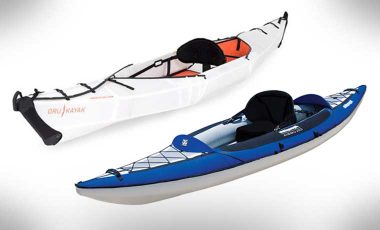This year I tried out what I thought was the ultimate portable kayak: the Oru Kayak Beach LT. When packed down, it’s the size of a large portfolio folder, weighs only 26lbs (11.8kg) and can be transported very easily without the assistance of anyone else. It’s a total winner for independent, zero-faff paddling. It also paddles very nicely on flat water and it’s super quick to set up.
I’ve loved paddling the Oru Kayak this summer. So much so, that since the release of Oru’s brand new, smaller, lighter, cheaper and even more packable Inlet, I’m considering getting one myself. However, despite the friendlier price tag of the new Inlet, it’s still a big spend. Plus, I love paddling inflatable kayaks for their versatility in different conditions and paddling scenarios.
To help me make a more informed decision about whether the new Oru Kayak Inlet is the right kind of portable kayak for me, I decided to delve a little deeper. What are the pros and cons of a folding vs inflatable kayak? And which is best for me?
Hopefully the answers to my questions will also help you in your quest for the most suitable portable kayak for your needs and lifestyle. And by the end of it we can all paddle happily ever after!
- What is a portable kayak?
- Types of portable kayaks
- The benefits of having portable kayak
- The negatives of portable kayaks vs regular kayaks
- Inflatable vs folding kayak
Disclaimer: We use affiliate links and may receive a small commission on purchases.
What is a portable kayak?
Before we go any further, it’s probably a good idea to explain exactly what I’m talking about when I talk about a kayak being portable. Yes, all kayaks are portable. It would be a paddling nightmare if they weren’t! However, some are most certainly more portable than others. So, to make sure we’re all the same page, here are some key properties of a portable kayak:

Easy to carry on your own
Ideally, a portable kayak should be lightweight enough to be easily carried by one person. But it should also be a convenient shape and size for one person to deal with so that it can be carried further than from the parking lot to the water’s edge. So it should fit inside a backpack or a bag with a shoulder strap so that paddlers can walk further with it to get to secluded spots.
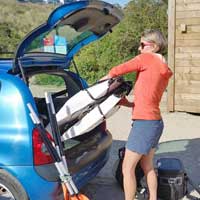
Easy to transport
If a portable kayak is easy to carry, then transporting it in a car should be a breeze. Any kayak can be strapped to the roof of a vehicle, but in the world of zero-faff portable kayak paddling, there is no need for such unnecessary actions. Even a small car should be able to house a truly portable kayak inside of it. City dwellers can also carry a portable kayak on public transport to get to their nearest watery retreat.
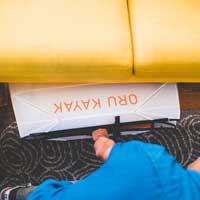
Doesn’t need much space to store
Another hugely key feature of portable kayaks is that they don’t take up much storage space. Many people don’t have the luxury of a garage or garden to store a regular kayak. So the ability to chuck a portable kayak behind the sofa, under the stairs on inside a cupboard in your flat suddenly makes paddling way more accessible to lots of folk.
Types of portable kayaks
Folding kayak
 Folding or origami kayaks are gaining popularity at a fast rate of knots. They seat one or two people and are usually made from durable double layer polypropylene (a kind of corrugated plastic).
Folding or origami kayaks are gaining popularity at a fast rate of knots. They seat one or two people and are usually made from durable double layer polypropylene (a kind of corrugated plastic).Inflatable kayak
 Inflatable kayaks are the most common type of portable kayak thanks to their relatively low cost. They are constructed of tough and highly durable hypalon, PVC or nitrylon and seat one, two or three people.
Inflatable kayaks are the most common type of portable kayak thanks to their relatively low cost. They are constructed of tough and highly durable hypalon, PVC or nitrylon and seat one, two or three people.
Nesting / modular kayak
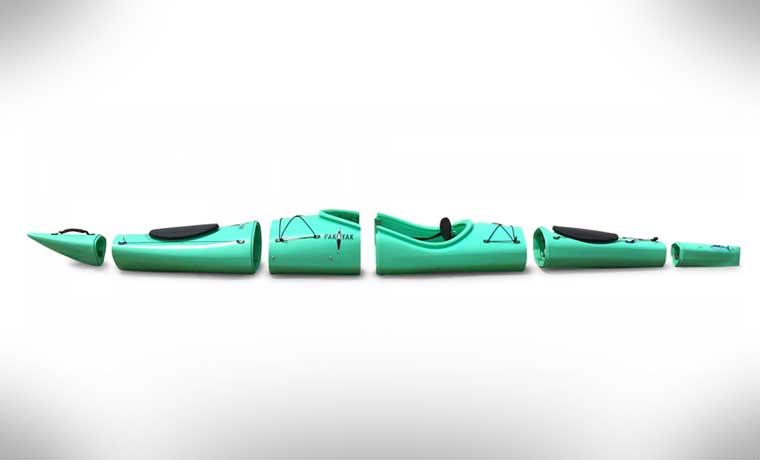 Nesting or modular kayaks are not particularly common and are not as portable as their folding and inflatable counterparts. Despite that, they are still more portable than a regular kayak and are worth mentioning for the sake of completeness. The Pakayak is a good example of a nesting kayak.
Nesting or modular kayaks are not particularly common and are not as portable as their folding and inflatable counterparts. Despite that, they are still more portable than a regular kayak and are worth mentioning for the sake of completeness. The Pakayak is a good example of a nesting kayak.
The benefits of having a portable kayak
You should already be picking up on the huge benefits of portable kayaks vs regular kayaks (portability, storage, independence for solo paddlers, low weight etc). Here are a few more reasons why a portable kayak — folding or inflatable — might just be the right type of kayak for you:
It’s easier to get to really remote places
If you’ve ever tried hauling a regular kayak on your shoulder for more than a few hundred meters then you’ll know how important it is to gain easy access to the water’s edge. This means you are highly limited when it comes to water-based exploration. Stick a portable kayak on your back, however, and suddenly your options are endless. You can hike to remote sea coves, hidden rivers and even alpine lakes to paddle.
Getting to the water is just much easier!
Even if you’re not bothered about getting to remote places, a portable kayak makes even regular launches MUCH more straightforward. Some beaches have very steep dunes to negotiate, for example. Or slipways that continue straight up a hill to where your car is parked. Because of that, kayakers often use a trailer to wheel their vessel to and from the water’s edge. No need for that with a portable kayak!
You can kayak camp away from the water’s edge
Sometimes it’s tricky to find waterside camping spots on multi-day kayaking trips. Hike a little way inland and there’s often a load of options. If you have a regular kayak then you’ll either have to leave it at the water’s edge, hide it in the undergrowth near the water, or haul it to your camping spot. With a portable kayak, however, you can just pack it up and carry it to wherever you want to camp without worrying about it, and with very little effort.
The negatives of portable kayaks vs regular kayaks
There are a lot of different types of kayaks that are suited to different paddling types, styles, locations and conditions. Unless you’re in the market for a recreational kayak, here are a couple of reasons why opting for a portable kayak may not be for you:
Performance
Portable kayaks generally don’t compete with specific types of kayaks when it comes to performance. Playboating, racing, whitewater kayaking, sea kayaking or long distance touring all require boats of very specific shapes, sizes, materials and features.
Durability
Most regular kayaks are made from rotomolded polyethylene (recreational), polycarbonate plastic (mid range) or fiberglass (high end). Generally speaking, these materials are tougher, more robust and more durable than the polypropylene of folding kayaks or the plastic fabric of inflatable kayaks. Their hard shells are designed for use in extreme conditions. Obviously, this is not directly comparable as it depends on where and how the kayak is used, and also how it is cared for.

Inflatable vs folding kayak: Statistical comparison
Now we know a little more about why portable kayaks rock for recreational kayaking, it’s time to delve into the inflatable vs folding kayak conundrum.
Statistically, I’ve compared two similar kayaks: the Oru Kayak Beach LT folding kayak and the Aquaglide Columbia 110 inflatable kayak.
| Oru Kayak Beach LT | Aquaglide Columbia 110 | |
|---|---|---|
| Kayak type | Folding | Inflatable |
| Dimensions | 3.6 x 0.7m / 12 x 2.3ft | 3.45 x 0.9m / 11.3 x 3ft |
| Weight capacity | 136kg / 300lbs | 136kg / 300lbs |
| Number of seats | 1 | 1 |
| Weight | 11.8kg / 26lbs | 13.6kg / 30lbs |
| Packed sized | 84 x 30 x 74cm / 33 x 12 x 29in | 67 x 22 x 48cm / 26.5 x 8.5 x 19in |
| Cost | $1299 | $500 |
Inflatable vs folding kayak: subjective comparison
This section of the inflatable vs folding kayak comparison is based on my experience paddling a double inflatable kayak for the last few years on both calm water and choppy seas, and full of overnight camping gear.
I have also spent the summer paddling the Oru Kayak Beach LT. I’ve had several outings in it on calm flat estuaries as well as in 2-3 foot swell on the open seas.
Read my full review of the Oru Kayak Beach LT for more information.
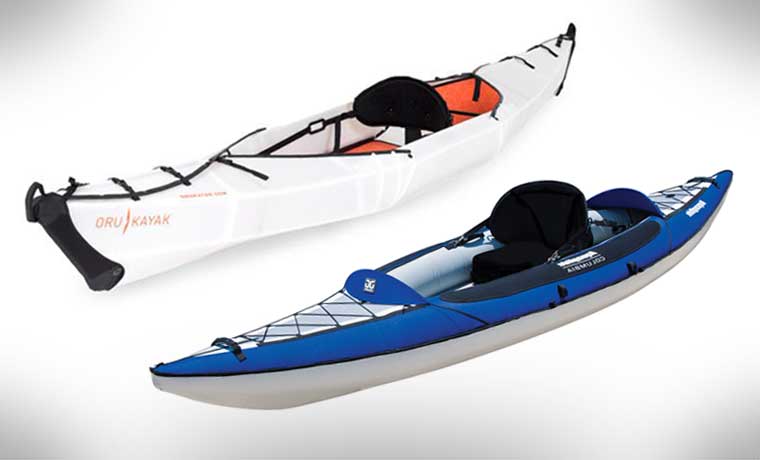
Setup time and effort
From an effort point of view, folding kayaks win without question for me. It’s also a little quicker to set up a folding kayak, and more straightforward, once you’ve done it once or twice.
Setting up an inflatable kayak is also a pretty easy process once you’ve figured it out. Getting the fin on and off can sometimes be a challenge, and there are more components to deal with, like inflating and securing seats. Plus, you’ve got to put some elbow grease into it!
That said, if you don’t need to carry your kayak far and have a car, inflating one with a car pump couldn’t be easier. But that’s no good from a portable point of view!
VERDICT: Folding kayaks win for me — they are super quick and straightforward to set up, with little physical effort required.
Drying out
A major downside of inflatable kayaks is drying them out. Stick one in the sun for a few hours and it’ll seem like it’s dried out a treat. But unfortunately the bits in between the folds will be saturated still. Getting a towel in there certainly helps. But to really dry them out takes a while.
Folding kayaks, on the other hand, dry out very quickly. Left in the sun and they will dry out in a couple of hours. But they’re also easy to towel down so that they’re pretty dry without having to leave out for ages.
VERDICT: Folding kayaks dry out much more quickly than inflatables.
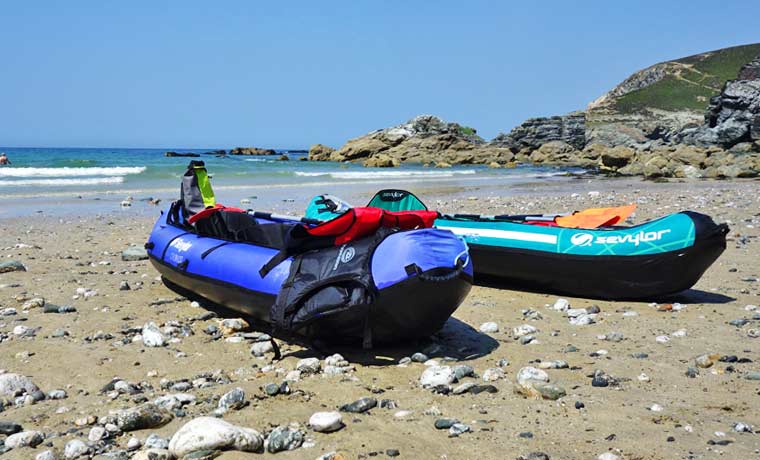
Portability
Most inflatable kayaks are heavier than folding kayaks. And that’s before they get wet. Once you’ve used an inflatable kayak, the fabric holds a lot of water weight before it’s properly dried out. Because of the slow drying time, carrying an inflatable kayak after use becomes harder and wetter(!) than prior to use. It’s also worth considering that wherever an inflatable kayak goes, a pump goes too. This adds to the weight and bulk of the package.
I also find it easier to deal with a folding kayak than an inflatable kayak when I’m on my own. Wet inflatable kayaks can be tough to pack away, especially when wet.
VERDICT: Folding kayaks win the day in terms of portability.
Durability
This is a tough one to measure. If the kayak in question is cared for correctly and only used in the recommended conditions then there’s no reason why both folding and inflatable kayaks shouldn’t last as long as each other.
That said, Oru Kayak advises that their kayaks last for 20,000 folds. That’s a lot of use! They are also puncture resistant and can be repaired relatively easily with a specially designed repair kit. This includes expanding foam sealant that can be injected inside the double-layered skin. I feel totally confident dragging the Oru over rocks and pebbly beaches. And even bashing into underwater rocks doesn’t feel too terrible.
Inflatable kayaks, on the other hand, could become punctured on their first outing. I would also never drag mine over rocks or rough surfaces, and I wince every time I bounce off a rock when in the water. But I do bounce off the rocks and don’t get a puncture. And punctures are pretty rare, to be honest. They are also very easily repaired.
VERDICT: The jury is still out. Ask me in 10 years!
Versatility
Most folding kayaks are designed with specific conditions in mind. The Oru Kayak Beach LT is only suited to paddling on calm, flat water in low wind, for example. There are other Oru models that deal with rough conditions much better, but you’ll need to fork out a fair bit more for the privilege.
Folding kayaks tend to have a lower maximum weight capacity than inflatable kayaks making them less suited to carrying lots of gear or heavy humans. Again, this does depend on the model, as the two models in this comparison have the same recommended maximum capacity.
Most inflatable kayaks handle well in a variety of conditions at recreational level. Though they’ll struggle on any significant whitewater rivers, most mid range inflatable kayaks cruise through grade 2 rapids. They also deal with low impact crashes into rocks and boulders with much less drama than a folding kayak. Plus, they can hold decent amounts of gear and weight for overnight canoe camping trips in choppy and breezy conditions.
When comparing the Beach LT to the Sevylor Madison, the latter wins by miles in terms of versatility. However, when considering other folding kayak models this is not so cut and dry, with folding kayaks putting up a good fight!
VERDICT: Inflatable kayaks provide more versatility for recreational paddlers.
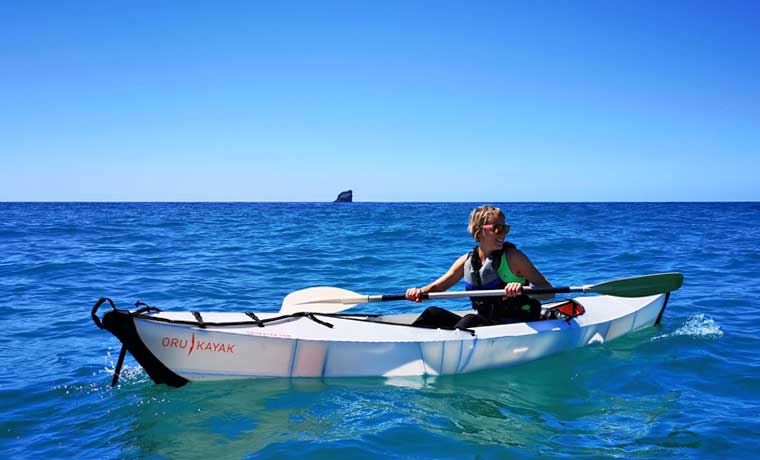
Performance
When paddled in the right conditions for the boat, folding kayaks are designed with high performance in mind. Yes, they’ll struggle to compete with regular kayaks in this department. But compared with inflatable kayaks they win on performance, hands down. This is down to their superior design, streamlined shape and low weight.
Inflatable kayaks tend to deal with windy conditions better than folding kayaks, mainly due to their higher weight and ability to load more into them. However, when it comes to speed and efficiency, inflatable kayaks are a boat’s length behind their folding counterparts.
VERDICT: Folding kayaks take the win, hands down.
Subjective comparison results
The results of my subjective comparison are:
| Folding kayaks | Inflatable kayaks | |
| Set up | √ | X |
| Drying out | √ | X |
| Portability | √ | X |
| Durability | Inconclusive outcome | |
| Versatility | X | √ |
| Performance | √ | X |
| Total | 4 | 1 |
Inflatable vs folding kayak: the verdict
The statistical comparison table above indicates that inflatable kayaks are preferable in terms of cost and pack size. Though folding kayaks weigh less.
The outcome of my subjective comparison is pretty clearly in favour of folding kayaks. Of the elements I’ve addressed, folding kayaks come out well on top, including for the most important feature of a portable kayak: portability!
However, versatility is a very important feature for me. I don’t want to have to have more than one kayak for different conditions. I live by the sea where there are waves and swell to negotiate and it is pretty windy more often than not. If I were to opt for a folding kayak then I’d need to choose a seaworthy version that would set me back a few extra hundred bucks. Plus, it’s important to me that I’m able to take my boat onto small river rapids.
Add to that the hefty price-tag attached to folding kayaks and, despite the inherent issues with inflatable kayaks, it’s inflatables all the way for me.
If I lived next to calm waters and didn’t have space in my garage to dry out an inflatable then I would seriously consider a folding kayak. They’re an absolute joy to paddle and yes, of the two types of portable kayaks available, folding kayaks are certainly more portable.
I hope that helps your quest for the right kind of portable kayak for your water-base adventures? And if not then try hiring or borrowing both so that you can feel and experience the difference first hand.
Either way, happy paddling, happy paddlers!
For more information about whether a kayak is the best boat for you, read our guide to the similarities and differences of canoes and kayaks,which includes the pros and cons of each.


